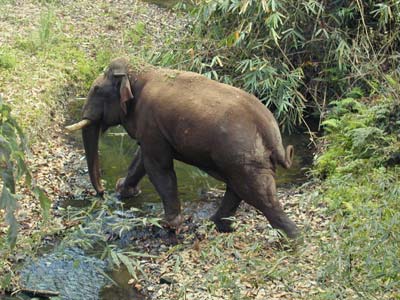 |
|
Elephent in the Forest |
|

|
Lancang River originates from the Qinghai-Tibet Plateau, it penetrates Yunnan from northwest to the south and transverses Xishuangbanna; after it inflows to the border areas of the Laos and Burma, it is called Mekong; and it passes through the Laos, Burma, Thailand, Cambodia and Vietnam and ingresses into the South China Sea at last. It is a famous international river in Asia and is often called the Danube of Asia. Lancang River is the Chinese translation for its Dai name, and it means "the river with millions of elephants" in the Dai language. There is a folktale in Xishuangbanna, which says: "Dai folks rely on elephants, and elephants depend on Dai folks". The story goes: when the ancestors of the Dai folks immigrated to the Lancang River valley, the folks and drought animals in the villages are often injured by tigers and the people were quite afraid. A wise old man hit upon an idea and he directed the folks to plant a lot of bamboos and banana plants. Elephants liked to eat bamboos and bananas, thus, they came to seek for food around the villages in groups; the tigers could not win over elephants, thus, they stayed away from the Dai villages. Nowadays, only 200-300 elephants are left in this part, they become animals in danger, and are protected in the protection area of the rain forest in Xishuangbanna. The abused hunting and the drastic changes of the ecological environment have changed Lancang River or "the river with millions of elephants"into a titular noun.
In history, the Dai folks tamed elephants and used elephants to work for them, and Xishuangbanna was known as the "kingdom riding on elephants" and famous for "battles with elephants"; and the place also intensified its communication with inland Chinese because it donated tamed elephants and elephant trucks to the rulers. Since the Dai folks regard elephant as the symbol of the mighty, the strong, the chaste and the steady, they treat elephants as the key topic in all forms of arts and literatures; and they pin their pursuit for "the true, the kind and the beautiful" on elephants.
In their legend for the creation of the world, their God creates 16 layers of heaven and earth, but the heaven and the earth keep shaking; the God gathers up some mud from his body and kneads it into an elephant, then, He kneads 6 pillars and put them on the back of the elephant; finally, the heaven and the earth become stabilized. From then on, elephants become a natural spirit worshipped by common folks and we could see various and exquisite sculptures of white elephants in front of temples. In folk dances, the dance of white elephant and the dance of elephant legs are statedly and popular and are welcome to all the Dai folks. The white elephant in the dance is made with bamboos frameworks and then covered with white paper, the head and the truck of the elephant could move. During performances, two people would sneak into the elephant body, they wear trousers similar with the legs of the elephant, just like the lion dance of the Han Chinese, and they would imitate all behaviors of the elephant. The dance of white elephant is normally performed in important occasions. The onlookers would cheer the dancers up by crying "shui", "shui".
The artistic images of elephants often appear in the frescoes of the temples, such as the painting of riding elephants; elephants also appear in various brocades and bags, and we could also find them being carved into white elephants in wood and bronze works. In the recent years, because of the development of tourism, all memorial articles expressed by elephants are seen everywhere. However, if one wants to have a look at the chaste bearing of wild elephants, they would have to try their luck in the "valley of wild elephants" in Xiaomengyang.


|